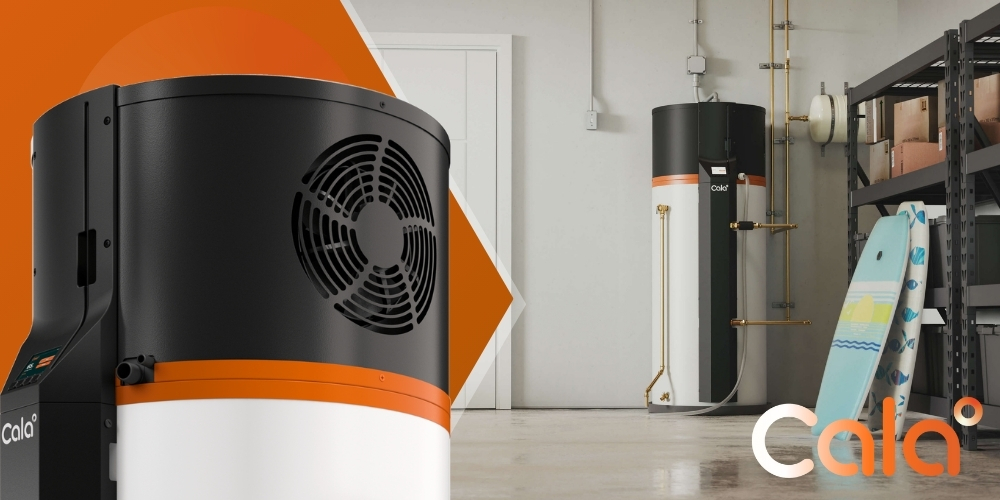What to Expect During a Ducted Mini Split Installation

Intelligent Heat Pump Water Heaters for Massachusetts Residential Homes — Why SumZero Selects Cala
By SumZero Energy Systems — Massachusetts’ #1 Heat Pump Installation Team
Picking a new water heater once involved a simple decision between gas and standard old electric, praying the hot water wouldn't be gone when there were two showers in a row. That's no longer the case. Now, the ideal solution for the majority of Massachusetts homes is a smart heat pump water heater (HPWH). This isn't the typical hybrid of which you might have heard, but a rather new breed of unit that adapts to your home's schedule, accommodates your energy usage, and maintains comfort consistently while consuming a lot less energy.
When homeowners want to have it exactly right the first time, our team is discerning about what products we choose. We consider the landscape and inspect the details before determining that they might work with Cala, a company that produces a high-technology hot water heater that modern homes need: intelligent, consistent, and efficient hot water — installed properly. This article describes why this alliance matters, how the tech benefits your home, what you should expect from our installation, and the handy information (rebates, credits, fit questions) homeowners inquire about daily.
Why This Alliance Is Important
(and What It Does for You)
There are two parts to a successful hot water solution:
Great technology
A system that makes you comfortable and uses less energy.
Great installation
Design, placement, airflow, electrical, condensate handling, commissioning, and long-term support.
Cala provides a tailor-built, smart HPWH platform. SumZero provides actual-world experience so that it works perfectly in real Massachusetts homes.
Together, we provide three things homeowners report wanting:
Accurate hot water at peak periods without guessing.
Cheaper monthly energy bills without compromise on comfort.
It is a future-proof solution that addresses the trend towards greener, all-electric homes.
Simply put: We get hot water. We know how to properly install heat pump technology. This combination makes a water heater upgrade a smart, long-term decision.
The Homeowner's Dilemma That We Are
If you have had a gas or a typical electric water heater, then you know the problems:
Hot-cold swings on hectic morning routines.
Higher electricity bills than hoped for.
No real insight, no real control.
A replace cycle that is experienced as "buying the same thing again."
Typical hybrid: Heat pump water heaters perform better, yet they still react: They delay until the tank cools off, then warm it up again. Homeowners averred they desire a system which thinks ahead—a unit which is a breeze to operate, handles peak load graciously, and does not make them compromise.
They fill that gap, which is why we work with them.

Why a Smart HPWH is Different
A standard electric water heater makes heat by passing an electric element, a giant toaster coil, through the tank. A heat pump water heater does it another way: it takes heat from the air it lives in and puts it into the water. Because it costs less energy to move heat than create it, heat pump water heaters run on much less power than typical electric ones. And they avoid burning gas, venting, and pollution.
A smart HPWH goes one step further:
It adapts to your home's schedule (morning showers, nighttime laundry) and preheats when demand isn't yet high.
You can use the app to check, plan, or increase hot water whenever you want.
It has a compressor that can change speed to fit what you need (not just "on/off").
It is achievable with a mixing valve holding water at the proper warmth for improved efficiency and then providing a sustained, safe warmth for usage. This is also possible with the availability of additional warm water at peak usage times.
It goes nicely with a contemporary home — primed for solar, time-of-use, and information you can view at a glance.
Result: more stable comfort, less energy use, improved control.
Why a Smart HPWH is Different
From what is visible on-site, there are three things certain for homeowners regarding the points of Cala:
1) Ease That Is Effortless
Consistent hot water at peak use is the ultimate test. Through forecasting demand and using a mixing valve, Cala maintains a steady supply. That results in less "uh oh" when two showers coincidentally happen at once or someone turns on the dishwasher.
2) Controls That You'll Ever Use
App functionality is key when done properly. You can check if there's hot water, turn up the heat for guests, view energy usage history, or simply set it and leave. As installers, we appreciate performance data — it allows us to address little issues before large ones form.
3) Future-Ready from Day One
Massachusetts is going towards clean, electricity-based homes. Cala's strategy combines well: it is scalable for solar power and accounts for time-of-use rates when needed. If you foresee solar energy at some time, or already have it, this water heater won't stop your home from being efficient.
4) A Company That Stands Behind Its Product
Cala backs every unit with a 10-year parts warranty and 3-year labor warranty — a strong sign they stand behind both the technology and the people who install it. At SumZero, we respect that kind of commitment because it mirrors our own approach: taking care of homeowners and supporting our partners with the same level of trust and accountability.
What SumZero Offers As Your Installer
(Why It Matters)
Even the best system won't work so great if installed wrong. Our task is getting your new HPWH working perfectly inside your home, not on a drawing board. This is what our approach is:
Right-size design.
We measure how much water your home needs and discuss the high-flow fixtures, filling bathtubs, and washer usage.
Best installation and ventilation.
HPWHs require air to make the heat move. We consider the room size, doors, vents, and — when necessary — ducting solutions for high performance and low noise.
Clean handling of electricity and condensate.
Safe power, tidy routing, and a trustworthy drainage plan are essential.
Commissioning correctly.
We don't just "turn it on." We verify performance, position the mixing valve, help you with the app, and verify your comfort objectives.
Rebates, credits, and financial assistance.
Mass Save, federal 25C, and the 0% HEAT Loan (if applicable) — we'll help you with that.
We take special care.
Our teams respect your home, protect your floors, and leave the place nicer than they found it.
Aftercare you can count on. Questions years down the road? We're here. The whole concept of a smart system is long-term confidence, not a one-day installation.
Costs, Incentives, and Lifetime Value
Two parts matter here: upfront cost and operating cost.
→ It is a better unit than a standard electric or simple hybrid. Tax credits and rebates make a big difference. A lot of Massachusetts homeowners rely on the 0% HEAT Loan for easier payments.
→ Month after month, the intelligent HPWH's effectiveness is where the value lies. By transferring (not creating) heat and by scheduling heating intelligently, homeowners consistently experience significant decreases in water-heating energy consumption — particularly relative to resistance electric, and many times relative to gas or delivered fuels when full costs are factors.
If you'd like figures specific to your home (household number, showering usage, energy costs), we'll do the math at your consult and provide you with a clear estimate of payback, lifetime cost saving, and the rebates for which you qualify.
Are Smarter Heat Pump Water Heaters Good for Your Home?
It is feasible for many Massachusetts homes. We will cover:
→ Household size and routines. Families with up to about 5 people usually do well with the standard setup; we will give advice for larger families or special situations.
→ Space and ventilation. We check the space, door vents, or ducts if necessary, and ventilation so the system operates properly.
→ Location. Basements are typical, as are utility rooms. As the unit functions, it removes air that feels like a dehumidifier — a typical plus for basements.
→ Electrical. We check panel capacity and proper wiring; no installation day surprises.
→ Future plans. Now or in the future for solar? Time-of-use rates? We'll put the system on so it grows with your home.
[[cta-heatpump]]
Why Is Cala Different from "Traditional Hybrids"?
✪ Control and Convenience:
Cala integrates intelligent tech with a mixing valve to remain comfortable, even when it is busy. Most standard hybrid units have simple modes and react only when the tank becomes chilled.
✪ Care and Trust:
Performance insights help you recognize problems early on and keep you on your feet for surprises. Traditional deployments are mostly "wait and see."
✪ Timing and Efficiency:
Variable driving and improved scheduling assist in energy saving with the maintenance of comfort. Ordinary hybrids operate more often and at undesirable times.
✪ Future-Ready
The design of the Cala accommodates with solar power, intelligent homes, and plans for utilizing electricity. Most older hybrids were not built for that usage.

What to Expect with SumZero
(From the First Call Through the First Shower)
✪ Talk & Pictures
We'll first glance at your objectives and take some fast photos of the current installation: the water heating unit, panel, and surrounding room.
✪ Right-Fit Design
We fit your hot water consumption and available spaces to a design which we endorse.
✪ Chaplain: A Comprehensive
Your quote is going to be transparent, includes information for installation, accessories, and a checklist for incentives. The paperwork assistance takes care of our end.
✪ Professional Installation
Licensed, insured, and detail-orientated. We dispose of the old unit, prepare the site, install and commission a new system, and leave the site tidy.
✪ App Introduction and Instructions
You'll discover how to see hot water supply, schedule increases, and view consumption — without being "technical."
✪ Support and Help
We're your long-term partner. Got a question? You call us — that's what homeowners deserve from the #1 heat pump installation company.
Common Questions We Get
(And Easy Answers)
Smart heat pump water heaters move heat from the surrounding air into the water instead of generating heat directly. This makes them up to three to four times more efficient than standard electric models. Cala’s intelligent system takes it further — it learns your household’s patterns, preheats before busy periods, and gives you app-based control to monitor or boost hot water anytime.
Most hybrid water heaters react when the tank cools. Cala predicts when your home will need hot water and heats proactively, saving more energy while maintaining comfort. It also features a variable-speed compressor, integrated mixing valve, and performance monitoring portal, giving both homeowners and installers a smarter, more reliable experience.
Savings depend on your energy source and usage, but many Massachusetts homeowners cut their water-heating costs by 50–70% when switching to a heat pump system. Cala’s intelligent controls add even greater efficiency. Add Mass Save® rebates, federal 25C tax credits, and potential 0% HEAT Loan financing, and most families see real payback within just a few years.
Yes — most Massachusetts homes are a great fit. Cala’s 65-gallon design comfortably serves households up to five people and can prepare up to 90 gallons ahead of peak use. The system needs adequate space and airflow, similar to a dehumidifier, and our team at SumZero handles every detail — from placement and ducting to electrical and performance checks.
SumZero Energy Systems is Massachusetts’ #1 heat pump installation team, trusted for precision, transparency, and high-quality service. We manage every step — design, installation, rebate paperwork, app setup, and long-term maintenance — so homeowners enjoy smarter comfort and lasting confidence. With SumZero, you’re not just buying equipment; you’re gaining a partner who stands behind it.
Why We Feel Secure Recommending This to Massachusetts Homeowners
We have a simple promise: we only install solutions that we would use in our own homes. Cala’s approach — being smart, having control, and being ready for the future — matches what we have learned from many talks with homeowners in the state. Together with SumZero’s careful installation standards and ongoing support, this water-heating upgrade makes sense right away and will last well with your home. Cleaner heat. Smarter comfort. Fewer bills.
Ready to Take the Next Step?

To learn more about Cala’s technology and vision, visit Cala Systems.
Understanding the Ducted Mini Split Installation Process
If you're a Massachusetts homeowner exploring better ways to heat and cool your home efficiently, a ducted mini split system might be the upgrade you're looking for. Known for merging the benefits of traditional ductwork with the modern efficiency of mini split technology, these setups offer a clean solution for energy savings and improved indoor comfort. But what does the installation process really look like?
Knowing what to expect from start to finish can help you avoid surprises and make the right decisions for your home and budget.
Initial Home Assessment and Custom Planning
Before anything is installed, your home must be properly evaluated to customize the system for optimal performance.
- Room dimensions are measured to calculate BTU requirements.
- Existing ductwork (if any) is inspected for compatibility or potential upgrades.
- Considerations like insulation, windows, layout, and even attic conditions come into play.
Many Massachusetts homes have insulation and air sealing issues that reduce HVAC efficiency—making proper planning essential to avoid energy waste.
Once this is complete, you’ll receive a layout plan that includes air handler placement and duct designs. Here’s when you’ll also discuss your preferences, such as single-zone or multi-zone configurations.
Pre-Installation Preparation
Prior to installation day, several preparation steps take place:
- Equipment is ordered and delivered (e.g., air handler, outdoor unit, ducts).
- An electrical assessment ensures your panel supports the system’s load.
- Technicians identify your system’s best route—through attic, crawlspace, or walls—to preserve home aesthetics and structure.
At this stage, everything gets lined up for a smoother installation experience.
[[cta-heatpump]]
What Happens on Installation Day
Expect the full ducted mini split installation to take one to three days, depending on your home’s complexity. This phase is where comfort begins to take shape, quite literally.
Indoor Equipment Installation
The air handler is typically hidden in a central location like an attic or basement. From here, ducts distribute air through vents installed in ceilings or walls.
Why homeowners love this setup:
- Minimal indoor units visible in living spaces
- Air is evenly distributed throughout zones
- Noise is reduced with the air handler placed away from living areas
A mini split ducted HVAC system can reduce energy usage by up to 30% compared to standard HVAC, especially when designed with zone control in mind.
Outdoor Unit Hookup and Refrigerant Lines
Outside, technicians mount the condenser and connect it to the air handler via insulated refrigerant lines. These lines travel through carefully drilled holes in walls or flooring, sealed properly to prevent moisture or drafts.
Key considerations:
- Outdoor unit must be placed level, with proper drainage
- Clearance is left for airflow and future servicing
- Electrical connections are tested and surge protection may be added
All this ensures long-lasting performance during both blazing July heat and frigid Massachusetts winters.
System Testing and Final Adjustments
After installation, your equipment is not just turned on—it’s thoroughly tested.
- Thermostats are calibrated
- Airflow is balanced across rooms
- Refrigerant is measured and adjusted as needed
This testing phase ensures your new energy efficient ducted mini split system operates exactly as planned—with no guesswork.
Living with a Ducted Mini Split HVAC System
Once installed, your new system becomes part of daily life—and the benefits become quickly noticeable. But to truly get the most from your investment, it’s important to understand how to maintain and monitor its performance moving forward.
Everyday Benefits for Homeowners
Massachusetts homeowners switching to ducted mini split HVAC enjoy several immediate advantages:
- Better temperature control across multiple rooms
- Quieter operation compared to forced-air systems
- Lower monthly energy bills year-round
- High compatibility with Mass Save® incentives
Plus, redesigned ducting often eliminates hot and cold spots common in older homes.
With incentives and rebates available through programs like Mass Save®, homeowners can potentially save thousands on installation costs.
Ongoing Maintenance Tips
To keep your ducted system running flawlessly, minimal upkeep is needed—just some simple routines:
- Replace or clean filters every 2–3 months
- Schedule an annual inspection before winter
- Keep outdoor units free of snow, leaves, and debris
- Monitor your thermostat settings to avoid overworking the system
Because these systems are built for efficiency, even small seasons’ adjustments can translate into big long-term savings.
Signs of Long-Term ROI
The return on investment becomes clear within a year or two:
- Reduced energy usage from more efficient heating and cooling
- Increased home value due to modern HVAC upgrade
- Enhanced indoor comfort through zoned temperature control
And with today’s smart thermostats and zone options, Massachusetts homeowners are also future-proofing their homes for evolving climate needs.
Final Thoughts
Choosing a ducted mini split installation isn’t just a mechanical update—it’s a decision to embrace quieter comfort, greater energy efficiency, and a more tailored indoor experience across seasons. By understanding the step-by-step process, homeowners in Massachusetts can feel confident navigating the upgrade with clarity and ease.
Whether you're replacing an aging furnace or building out a new addition, a ducted system could be the ultimate solution for whole-home comfort—without the compromises of older HVAC technology.
Ready for a quieter, more energy-efficient home? Discover how a ducted mini split HVAC system can transform your comfort while cutting utility costs—see if it’s the right fit for your home today.
Schedule Ducted InstallationYou Might Also Like…
Continue learning with handpicked articles that inform and inspire.
Not Sure Where to Start? We’ll Guide You
Let our experts design the right heating and cooling solution—customized for your comfort, your layout, and your energy goals. No pressure. Just clarity.
Request FREE ESTIMATE









